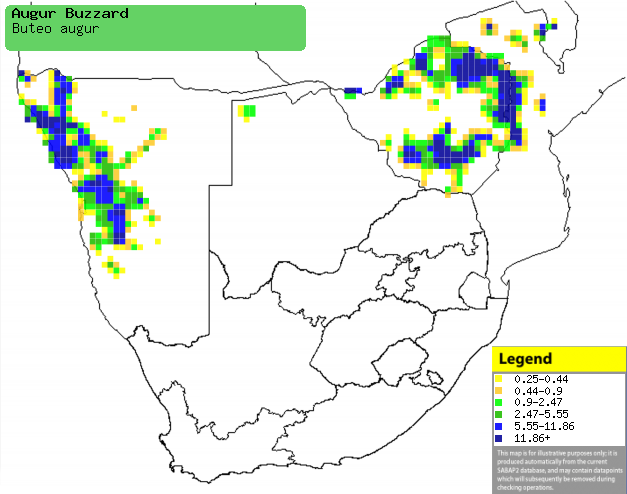|
Buteo augur (Augur buzzard)
Witborsjakkalsvoël [Afrikaans]; augurbuizerd [Dutch]; Buse
augure [French]; Augurbussard [German]; Bútio-augur [Portuguese]
Life
> Eukaryotes >
Opisthokonta
> Metazoa (animals) >
Bilateria >
Deuterostomia > Chordata >
Craniata > Vertebrata (vertebrates) > Gnathostomata (jawed
vertebrates) > Teleostomi (teleost fish) > Osteichthyes (bony fish) > Class:
Sarcopterygii (lobe-finned
fish) > Stegocephalia (terrestrial
vertebrates) > Tetrapoda
(four-legged vertebrates) > Reptiliomorpha > Amniota >
Reptilia (reptiles) >
Romeriida > Diapsida > Archosauromorpha > Archosauria >
Dinosauria
(dinosaurs) > Saurischia > Theropoda (bipedal predatory dinosaurs) >
Coelurosauria > Maniraptora > Aves
(birds) > Order: Falconiformes
> Family: Accipitridae
> Genus: Buteo
Distribution and habitat
Occurs in a band from Eritrea and Ethiopia, to Zambia,
Angola, Namibia, Zimbabwe and central Mozambique. It generally favours mountainous or hilly
areas with rock outcrops, especially with woodland, savanna, scrub or montane
grassland.
|
 |
|
Distribution of Augur buzzard in southern Africa,
based on statistical smoothing of the records from first SA Bird Atlas
Project (©
Animal Demography unit, University of
Cape Town; smoothing by Birgit Erni and Francesca Little). Colours range
from dark blue (most common) through to yellow (least common). |
Predators and parasites
- Predators of chicks and eggs
- Parasites (found in a chick's nostrils)
- Passeromyia heterochaeta (Tropical nest fly larvae)
Movements and migrations
Resident, although juveniles disperse from
their parents' territory once they become fully independent.
Food
It mainly eats reptiles, supplemented with mammals and
birds, doing most of its hunting from a perch or from the air, swooping to the
ground before grabbing its prey. The following food items have been recorded
in its diet:
Breeding
- Usually a monogamous, territorial solitary nester, although both polyandry (two males
mating with one female) and polygyny (one male
mating with two females) have been recorded. In a courtship display the male repeatedly dives at
a
perched female, or alternatively they may dive synchronously before locking
their talons.
- Egg-laying season is from July-November, peaking from August-October.
- It almost invariably lays two eggs, 2-4 days apart, which are incubated by
both sexes for about 39-40 days.
- The older chick starts to attack its younger sibling as soon as it
starts moving; the younger chick is usually dead by the time it reaches 5-8 days old. The
remaining chick is closely brooded by the female up to ten days after
hatching, while the male delivers food to both of them. The chick leaves the nest
after about 50-60 days old, becoming fully independent after another 14-30 days
or so.
Threats
Not threatened.
References
-
Hockey PAR, Dean WRJ and Ryan PG 2005. Roberts
- Birds of southern Africa, VIIth ed. The Trustees of the John Voelcker
Bird Book Fund, Cape Town.
|
